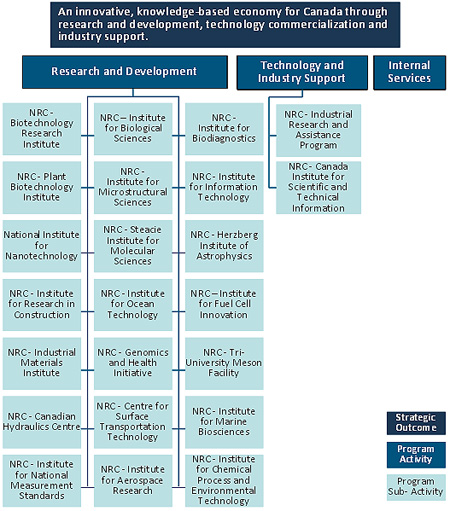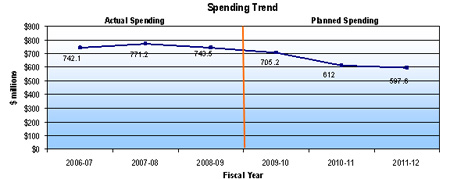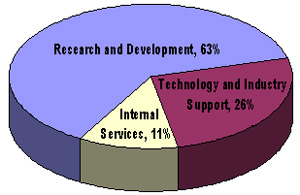Common menu bar links
Breadcrumb Trail
ARCHIVED - National Research Council Canada
 This page has been archived.
This page has been archived.
Archived Content
Information identified as archived on the Web is for reference, research or recordkeeping purposes. It has not been altered or updated after the date of archiving. Web pages that are archived on the Web are not subject to the Government of Canada Web Standards. As per the Communications Policy of the Government of Canada, you can request alternate formats on the "Contact Us" page.
Minister’s Message

As Minister of Industry, I am committed to the long-term competitiveness and prosperity of our country. Canada has many economic advantages upon which we must continue to build if we are to set the right conditions for our long-term success. With this in mind, Industry Canada and its Portfolio partners are striving toward the development of an innovative economy with robust sectors and an efficient and competitive marketplace.
Our priorities remain aligned with Advantage Canada, the government’s long-term economic plan. Here, we set out clear objectives, including the reduction of taxes, the encouragement of entrepreneurship, and the development of a knowledge-based economy.
In the 2009–2010 Report on Plans and Priorities, we recognize that as we look to the year ahead we are entering a period of continued global economic uncertainty, one that demands clear and strategic action on the part of the government to ensure we accomplish the long-term goals we have set for ourselves. Our departmental priorities and initiatives will be guided by a balanced consideration of the demands of the global economic situation and our long-term vision for Canada’s growth and prosperity.
In Budget 2009 — Canada’s Economic Action Plan, the government has developed a clear and comprehensive response to the slowdown in the global economy, which is in keeping with the continuing objectives of Advantage Canada. The economic action plan addresses short-term realities, while setting in place the conditions to strengthen Canada’s economy for generations to come.
Industry Canada and its Portfolio partners are at the heart of the government’s strategy to stimulate the Canadian economy. We are taking steps to improve the competitiveness of Canada’s traditional economy by providing short-term support for key sectors such as the auto industry. We are ensuring that all regions of Canada prosper by supporting economic diversification. We are fostering small businesses by improving access to credit and encouraging growth through tax reductions and incentives. We are supporting measures to develop a highly skilled workforce through such means as expanding the Canada Graduate Scholarships program. At this time of intense international competition for the world’s best and brightest, government support is helping to attract and retain these individuals in Canada. We are positioning Canada as a leader in the global knowledge economy.
In the ongoing pursuit of our mandate, we will continue to focus on innovation as a means to develop a globally competitive economy. Our ultimate goal is to help Canadians continue to enjoy a quality of life that is envied throughout the world.
It is my pleasure to present this year’s Report on Plans and Priorities for Industry Canada and its Portfolio partners, which will outline in greater detail the priorities and pursuits in which we will be engaged in the year to come.
Tony Clement
Minister of Industry
Message from NRC President

The National Research Council (NRC), Canada’s leading R&D Agency, is a key player in Canada’s science and technology infrastructure, helping to bring innovation from the labs to the markets.
In today’s global economy, industrial innovation is shaping the competitive position of nations. Canadian companies and communities across the country therefore uniquely benefit from NRC’s research excellence, state-of-the-art laboratories and commercialization capacity. NRC’s integrated science and technology solutions in key sectors of the Canadian economy help create market advantages that contribute to the competitiveness of Canadian industry and sustain our quality of life.
NRC creates value for Canada by transferring technology and knowledge to industry, championing regional technology clusters, securing access to global research networks and facilities, and enhancing international opportunities for Canadian firms and technology products. NRC’s role is crucial to improving the economic well-being of the country.
NRC’s strategy, Science at Work for Canada, is closely aligned with the Government’s science and technology strategy, Mobilizing Science and Technology to Canada's Advantage. NRC focuses its research and multidisciplinary competencies to address three national priority areas – health and wellness, sustainable energy, and the environment – areas where NRC can make the most significant contribution for Canadians.
NRC’s multidisciplinary expertise, its collaborative approach and its international networks are unique assets that help in developing solutions to complex national problems. By linking technologies such as biotechnology, information technology and nanotechnology with disciplines such as manufacturing, transportation, advanced materials and construction, NRC is pushing the boundaries of scientific and technological knowledge and capabilities, allowing for more sustainable economic growth for the benefit of all Canadians.
I am very proud to present the 2009-2010 Report on Plans and Priorities for the National Research Council Canada, highlighting how NRC will continue to contribute to an innovative, knowledge-based economy for all Canadians, through research and development, technology commercialization and industry support.
Dr. Pierre Coulombe
President
National Research Council Canada
Section I – Overview
1.1 Summary Information
1.1.1 Raison d’être
NRC is the Government of Canada's leading resource for science and technology (S&T) and innovation with a business focus on:
- improving the social and economic well-being of Canadians;
- fostering industrial and community innovation and growth through technology and industry support; and
- supplying excellence and leadership in research and development (R&D).
1.1.2 NRC Mandate
Under the National Research Council Act, NRC is responsible for:
- Undertaking, assisting or promoting scientific and industrial research in different fields of importance to Canada.
- Establishing, operating and maintaining a national science library.
- Publishing and selling or otherwise distributing such scientific and technical information as the Council deems necessary.
- Investigating standards and methods of measurement.
- Working on the standardization and certification of scientific and technical apparatus and instruments and materials used or usable by Canadian industry.
- Operating and administering any astronomical observatories established or maintained by the Government of Canada.
- Administering NRC's research and development activities, including grants and contributions used to support a number of international activities.
- Providing vital scientific and technological services to the research and industrial communities.
Consult http://laws.justice.gc.ca/en/showtdm/cs/N-15 for more details about NRC's legislative framework.
1.1.3 NRC Accountability Framework
NRC is a departmental corporation of the Government of Canada, reporting to Parliament through the Minister of Industry. NRC works in partnership with the members of the Industry Portfolio to leverage complementary resources and exploit synergies in areas such as innovation of firms through S&T, growth of small and medium-sized firms (SMEs) and economic growth of Canadian communities. The NRC Council provides strategic direction and advice to the President and reviews organizational performance. The President is the leader, responsible for fulfilling corporate strategies and delivering results. Each of five Vice Presidents (Life Sciences, Physical Sciences, Engineering, Technology and Industry Support and Corporate Services) has responsibility for a portfolio of research institutes, programs, and centres.
1.1.4 NRC Operating Environment
The federal S&T Strategy, Mobilizing Science and Technology to Canada’s Advantage, was launched in May 2007 laying out a plan to build three key advantages for Canada: an Entrepreneurial Advantage, a Knowledge Advantage, and a People Advantage. NRC has unique attributes that support the three Advantages in the federal S&T Strategy and shape its operating environment, including:
Entrepreneurial Advantage
- The ability to help companies move from discoveries in the laboratory to the development, prototyping and commercialization for the global marketplace – since 1995, NRC has spun off/in 68 companies, and in 2007-08 issued 98 licences.
- The ability to put together national programs for delivery in regions across the country.
- A national S&T infrastructure positioned to improve Canada’s innovation capacity in existing and emerging fields of research by building networks for researchers and businesses, training highly qualified personnel, creating new technology-based companies and jobs, and transferring knowledge and technology to Canadian companies.
- The capacity to adopt an integrated approach that brings research, technologies and industrial links together in delivering its mandate to provide access to international S&T infrastructures.
Knowledge Advantage
- Leading-edge knowledge generation capability – in 2007-08 alone, NRC published 1,330 articles in refereed journals, presented 821 papers at S&T conferences, and issued 1,541 technical reports.
- The capability to bring together multi-disciplinary research teams to tackle issues of national importance.
- The skills to manage research projects towards specific outcomes as well as long-term goals.
People Advantage
- A core strength of over 4,280 talented and dedicated people. In 2007-08, NRC researchers:
- held 217 positions on editorial boards of scientific publications
- were appointed to 473 adjunct professorships in Canadian universities
- were active in 118 national and international research networks
- hosted over 1,231 students, postdoctoral fellows and research associates
- engaged in 407 Canadian and 118 newly signed international collaborative agreements worth $159M and $108M respectively.
1.1.5 Strategic Outcome
To effectively pursue its mandate, the Agency aims to achieve the following strategic outcome:
- An innovative, knowledge-based economy for Canada through research and development, technology commercialization and industry support.
1.1.6 Program Activity Architecture (PAA)

1.2 Planning Summary
1.2.1 Financial Resources
| 2009-10 | 2010-11 | 2011-12 |
|---|---|---|
| 705.2 | 612.0 | 597.6 |
The decline in funding from 2009-10 and 2010-11 is largely due to the sunsetting of government funding for two major initiatives, including the Technology Clusters Initiatives and program funding for TRIUMF. The decline from 2010-11 to 2011-12 is largely due to the sunsetting of the Genomics Research and Development Initiative. In accordance with the normal budgetary cycle, these figures will be revised to reflect future decisions related to the renewal of sunsetting programs.
1.2.2 Human Resources
| 2009-10 | 2010-11 | 2011-12 |
|---|---|---|
| 4,504 | 3,996 | 3,996 |
1.2.3 Linkage between strategic outcome program activities and government of Canada outcomes
Strategic Outcome
An innovative, knowledge-based economy for Canada through research and development, technology commercialization and industry support.
Performance Indicators
Percentage change in private sector client capacity for innovation through growth of client firms. Growth in client capacity for innovation will be measured using the annual R&D expenditures of client firms and the number of technical staff devoted to R&D in client firms.
Targets
Establish baseline by FY 2009-10 with a 10% increase in client innovation capacity in subsequent years
| Program Activity | Expected Results | Forecast Spending ($millions) | Planned Spending | Alignment to Government of Canada Outcomes | ||
|---|---|---|---|---|---|---|
| 2008-09 | 2009-10 | 2010-11 | 2011-12 | |||
| Research and Development | Provide benefits to Canadians through excellence and leadership in research. | 444.3 | 439.9 | 350.8 | 339.9 | An Innovative and Knowledge-based Economy Strong Economic Growth |
| Technology and Industry Support | Enhanced innovation capacity of Canadian firms. | 215.8 | 184.8 | 186.1 | 185.9 | An Innovative and Knowledge-based Economy Strong Economic Growth |
| Internal Services | Enhanced efficiency of R&D activities | 83.4 | 80.6 | 75.1 | 71.8 | |
1.2.4 Contribution of Priorities to the Agency’s Strategic Outcome
All NRC priorities contribute to the achievement of its single Strategic Outcome
| Operational Priorities | Type | Description |
|---|---|---|
| Support Canada’s S&T Strategy | New |
Why is this a priority?
|
| Support and conduct R&D in key industry sectors | Ongoing |
Why is this a priority?
|
| Provide integrated industry support that engages key players | Ongoing |
Why is this a priority?
|
| Management Priorities | Type | Description |
|---|---|---|
| Ensure effective program management for a sustainable organization | Ongoing |
Why is this a priority?
|
1.2.5 Risk Analysis
Over the next year, developments in NRC’s strategic and operating environment will contribute to some notable risks for NRC. The global economic downturn is likely to affect the funding NRC receives directly and through client-based revenues and other partner contributions to research collaborations. Furthermore, the uncertainty of funding renewal for several key programs poses a significant risk to NRC’s ability to deliver on its objectives. As a result, NRC must develop contingency plans for managing in their absence and further leveraging limited resources. Recognizing the fiscal situation, NRC may need to re-scope or downscale its planned initiatives for the coming year.
As global competition for highly skilled scientific and technical personnel continues, NRC expects to have an increasingly difficult time competing within its current environment. This is compounded by the large investments that foreign governments are making in R&D and related infrastructure compared to Canada (e.g., National Institute of Standards and Technology in the U.S.) – a noted draw factor for high quality scientific and technical staff. External stakeholders expressed concern that it will become more difficult for Canada to compete in the longer term if it falls behind in these investments now. NRC is exploring options to address the challenges of attracting and retaining high quality people in its current HR plan, which is under development.
Adapting itself to the new operating principles of the federal environment, NRC sets priorities and manages the increasing workload as implementation of NRC’s Strategy, in line with the federal S&T direction, progresses. NRC strives to be agile and responsive to clients and stakeholders, while building awareness of NRC’s contributions and value to Canada. Lack of awareness is a risk that NRC is mitigating through creation of a new senior executive position and strategy focused on communications and stakeholder relations.
Some of the risks mentioned above can be found within the top 10 strategic risks for businesses in 2008 identified in a recent consultant report (Ernst & Young). These are expected to affect NRC either directly, in terms of a comparable and parallel risk, or indirectly through industry and other partners: regulatory and compliance risk, global financial shocks, aging consumers and workforce, emerging markets, industry consolidation/transition, energy shocks, execution of strategic transactions, cost inflation, radical greening, and consumer demand shifts.
Notwithstanding the risks and challenges expressed above, NRC’s science has managed to maintain a leading-edge as evidenced by the number of new national and international agreements signed. In the current operating environment, there are substantial opportunities where NRC, aligned with the priorities of Canada, is uniquely positioned to deliver value. Most notably, NRC:
- is an important and strong engine that will help to deliver on the federal S&T Strategy;
- bridges Canada’s fragmented innovation system (regionally based economies, large numbers of SMEs with limited capacity for R&D investment); and
- is ideally positioned to address complex industrial and social problems, capitalizing on converging science and technology trends with its impressive breadth of multi-disciplinary R&D capabilities.
1.2.6 Expenditure Profile
NRC forecast spending for 2008-09 is $743.5 million. Since fiscal year 2005-2006, spending increased by $8.6 million (or 1.2%).

The actual and planned spending for fiscal years 2005-2006 to 2008-2009 has averaged about $747.8 million per year. Total spending has remained relatively stable for this period and has only varied by two to three percent over the average. The planned spending of $597.6 million in 2011-2012 represents a decrease of $107.6 million from 2009-2010. This reduction is mostly a result of the sunsetting of funding for NRC initiatives and programs such as the Technology Clusters ($67.8 M), Genomics ($6.0M), and TRIUMF ($24.8M). Funding has been provided on a 5-year basis and will sunset at the end of term. The NRC is currently working towards renewing the sunsetting funds and the planned spending will be adjusted in a future Report on Plans and Priorities in the event that new funding is approved.
2009-10 Allocation of Financial Resources by Program

| Vote # or Statutory Item (S) | Truncated Vote or Statutory Wording | 2008–09 Main Estimates ($ millions) |
2009-10 Main Estimates ($ millions) |
|---|---|---|---|
| 50 | Operating expenditures | 385.5 | 397.6 |
| 55 | Capital expenditures | 39.7 | 42.2 |
| 60 | Grants and contributions | 143.6 | 140.6 |
| (S) | Contributions to employee benefits plans | 46.0 | 45.7 |
| (S) | Spending of revenues pursuant to paragraph 5(1)(e) of the National Research Council Act | 83.5 | 79.0 |
| Total | 698.3 | 705.2 | |
Note: * Vote numbers have changed between 2008-09 and 2009-10. A “/” separates the 2008/09 figure, listed first, and the 2009/10 figure, listed second.
| 2008-2009 | 2009-2010 | Net Increase/ (Decrease) |
|---|---|---|
| 698.3 | 705.2 | 6.9 |
| 2008-2009 | 2009-2010 | Net Increase/ (Decrease) |
|---|---|---|
| 4.9 | 5.0 | 0.1 |
Note: Due to rounding, figures may not add to total shown.
